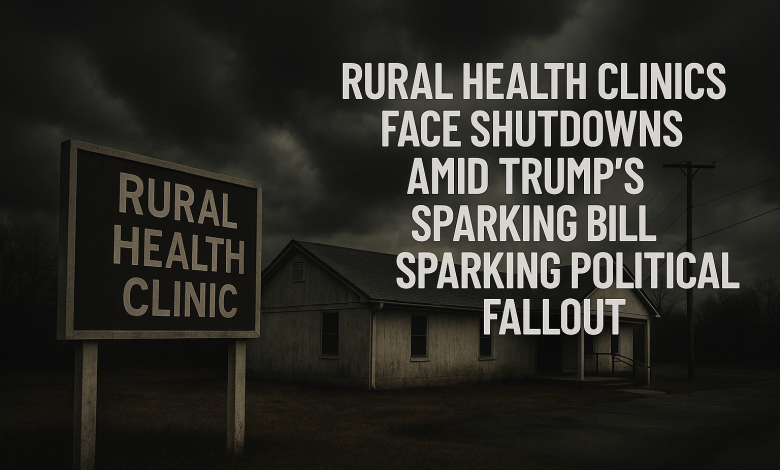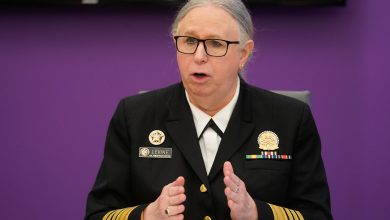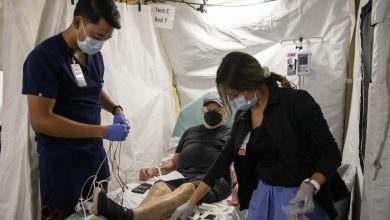Rural Health Clinics Face Shutdowns Amid Trump’s Landmark Bill, Sparking Political Fallout

A Crisis Brewing in America’s Heartland
Across the quiet farmlands, small towns, and remote communities of America, a silent crisis is unfolding. Rural health clinics—long considered the backbone of primary care for millions—are facing shutdowns at an alarming rate. The cause, many say, lies in the sweeping changes introduced under former President Donald Trump’s landmark healthcare bill, which has ignited fierce debate across political lines.
For patients in rural America, the stakes couldn’t be higher. Losing a rural clinic often means losing the only accessible doctor within 50 miles. For healthcare workers, it means unemployment and disillusionment. For politicians, it signals a storm of political fallout that could shape the narrative of the next election.
Why Rural Health Clinics Matter
Before unpacking the politics, it’s important to understand what’s at risk. Rural health clinics are more than just small doctors’ offices. They are:
- Lifelines for underserved populations – From farmers and veterans to low-income families, these clinics often serve those with few alternatives.
- Emergency first responders – In areas where hospitals are closing, rural clinics handle urgent care, stabilizing patients before transfer.
- Economic anchors – They employ local staff, nurses, and doctors, contributing to fragile rural economies.
Without them, rural residents face increased travel, higher medical costs, and even life-threatening delays in treatment.
Trump’s Landmark Bill: Reform or Retreat?
Supporters of Trump’s bill hail it as a landmark reform, claiming it reduces bureaucracy, reins in spending, and prioritizes efficiency. However, buried within its provisions are funding changes and new regulations that critics argue are crippling rural clinics.
Key contested elements include:
- Cuts to Medicare and Medicaid reimbursements – Rural clinics rely heavily on these payments. With reductions, many can no longer cover basic operating costs.
- Shifting power to private insurers – This move increases profit margins for big companies but leaves small clinics scrambling.
- Reduced federal grants – Essential funding streams for underserved areas have been scaled back.
To supporters, this is fiscal responsibility. To critics, it is a death sentence for rural healthcare.
Stories from the Ground: When Clinics Close, Communities Suffer
Statistics can feel abstract, but the reality on the ground is heartbreakingly clear.
- In Kansas, a rural clinic that served three counties shut down after funding cuts, forcing elderly residents to drive over 70 miles for care.
- In West Virginia, a diabetic patient missed regular check-ups when her clinic closed. She later faced a medical emergency that could have been prevented.
- In Texas, parents now struggle to find pediatric care for their children, with the nearest clinic two hours away.
These stories highlight not just inconvenience but human suffering. They are fueling anger, frustration, and political mobilization across rural America.
Political Fallout: A Firestorm in Washington
The closures are no longer just a healthcare issue—they’ve become a political battlefield.
- Republicans argue that Trump’s bill is misunderstood and that the reforms are necessary to cut waste and encourage innovation.
- Democrats frame the closures as proof of neglect for rural America, pointing to the human toll.
- Independent voters—many of whom live in rural states—are caught in the middle, increasingly skeptical of Washington’s promises.
The issue is also reshaping electoral dynamics. States like Pennsylvania, Wisconsin, and Georgia—already battlegrounds—are seeing rural healthcare emerge as a campaign talking point.
The Emotional Undercurrent: Betrayal in Rural America
What makes this crisis especially explosive is the emotional sense of betrayal. Many rural voters were among Trump’s most loyal supporters. They embraced his promises of standing up for the “forgotten man and woman.”
Now, facing clinic closures and reduced access to care, some feel abandoned. As one Iowa farmer put it:
“We voted for change, not for losing our only clinic. Now we’re paying the price.”
This sentiment resonates across social media, town halls, and even church gatherings. Rural America’s faith in politics is being tested like never before.
The Bigger Picture: Health Inequality Widens
The closures are not happening in isolation—they’re part of a growing divide in American healthcare.
- Urban areas enjoy advanced hospitals, specialty care, and telehealth options.
- Rural areas face declining access, older populations, and rising chronic disease rates.
The result is a deepening inequality that goes beyond health—it affects education, economy, and even life expectancy.
According to public health experts, this could shorten lives, increase healthcare costs, and fuel resentment between urban and rural communities.
Media Coverage: Headlines That Spark Debate
The media has been quick to seize on the political and human drama. Headlines such as:
- “Trump’s Healthcare Bill Leaves Rural Clinics on Life Support”
- “Small Towns Lose Doctors, Face Uncertain Future”
- “Political Fallout Mounts as Rural America Reacts”
These stories not only inform but also fuel emotional reactions, ensuring the issue remains front-page news.
Could There Be Solutions?
While the debate rages, several proposals are being floated:
- Restoring targeted funding for rural clinics through bipartisan amendments.
- Expanding telehealth to bridge distance barriers.
- Incentivizing doctors and nurses to work in underserved areas through loan forgiveness programs.
- Public-private partnerships that ensure rural communities are not left behind.
Whether Congress has the will to act remains uncertain. What is clear is that rural voices are demanding action.
The Election Factor: Rural Votes on the Line
With elections looming, the political fallout could be massive.
- Republicans risk alienating their base if rural communities continue to feel abandoned.
- Democrats see an opportunity to make inroads by championing access to healthcare.
- Third-party movements could capitalize on growing discontent.
In a tight race, the closure of a single clinic could sway thousands of votes—and potentially tip the balance in swing states.
Conclusion: A Nation at a Crossroads
The fate of rural health clinics is more than a policy debate—it’s a test of America’s values. Do we prioritize fiscal cuts over human lives? Do we allow rural communities to be forgotten, or do we ensure that every American, regardless of zip code, has access to care?
The answer will shape not only healthcare but also the country’s political future.
For rural Americans, this isn’t an abstract argument. It’s about whether they can see a doctor when they’re sick, whether their children get vaccinated, and whether their elderly parents live with dignity.
As Trump’s bill continues to spark closures and controversy, one thing is certain: the political fallout has only just begun.




